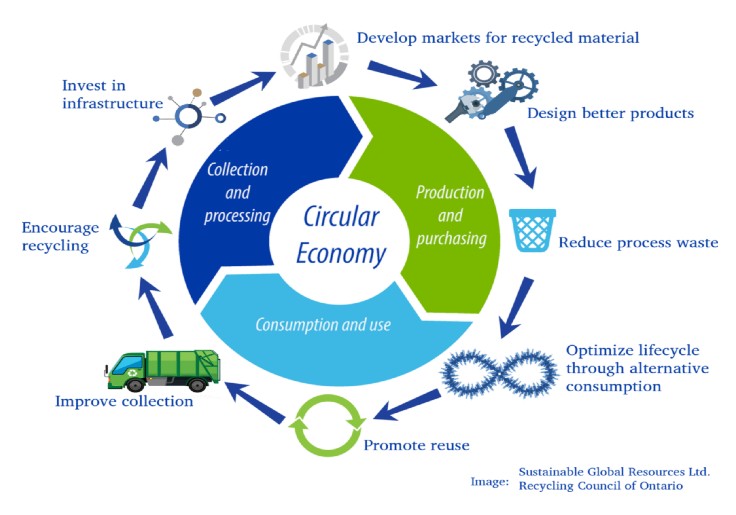With many resources becoming more and more scarce and pollution becoming a bigger problem every day, many countries, communities and organizations are embracing the circular economic approach, which supports the elimination of waste and the continual reuse of resources. Our old approach—the linear economic system, which is based on the take-make-consume-throwaway pattern—is still in use throughout most of the world to this day. In this type of economy, products are not properly recycled or reused, and the existing methods of recycling materials are not sufficient to adequately mitigate the resource depletion and damage done to our environment.
What is the circular economy?
The circular economy is a system of resource utilization that encourages the reuse, reduction, and recycling of waste in order to minimize production. This system also promotes the use of biodegradable materials in the manufacturing process. This is done to ensure that carbon goes back into the soil and can be used again for agricultural purposes, without causing environmental damage or pollution at the end of the product’s life cycle. Furthermore, a circular economy aims to redefine growth while focusing on the positive benefits of recycled materials. Unlike other economic models, this model creates substantial improvement for most businesses and consumers. Organizations that implement this system usually discover that reusing raw materials and designing products to fit into the circular economy are generally more cost-effective and less energy-intensive than creating new ones from scratch. Often, production prices are also radically reduced in the process, while sales prices are lowered, thereby benefiting the consumers, as well.
Principles of the Circular Economy
The circular economy is defined by seven key principles which include:
- Waste must be seen as resources.
- Products that do not fit into the consumer’s initial needs must be reintroduced into the economy
- Certain products and their parts can be reused
- Damaged products can be given a second life through reparation
- Make use of products found in waste through recycling
- Generate energy from renewable sources
- Harness energy from waste that can’t be recycled.
Countries embracing the circular economy
Many countries and regions are embracing the circular economy approach due to the benefit this system offers. For instance, states like California are leading the effort in passing new laws, such as the California Circular Economy and Plastic Pollution Prevention Act that reduces waste and ensures that plastic is designed to be reused effectively. In addition, the EU has also placed a ban on the importation of plastics from China; this is a new way of handling waste from plastic and triggering investment in recycling and reuse of plastic waste. Even China—where there has been an incredible amount of rapid industrial and infrastructural development, with seemingly little concern for the environment in the past—is starting to adopt these principles. With the first national law that promotes the efficiency of resource use in the country passed in 2009—the Circular Economy Promotion Law— China could be ready to embrace the Circular Economy approach to waste management, as well.
Applying the Principles of Circular Economy in Human Waste Management
The circular economy sees human waste as resources rather than mere waste. Turning human excrement into agriculture manure, animal feeds, and energy could create a valuable stream of income for people and also increase interest in sanitation. A report from the Toilet Board Coalition, an association of toilet brands, shows that the home toilet system can be monetized to become a serious business in the future if human waste is seen as a resource and not waste. And this is what a circular economy is all about. This system encourages the recycling of human waste to create a self-sustaining sanitation business and encourages people to invest in sanitation while reducing reliance on public funding. For instance, in a circular economy, human waste can be turned into energy in the form of biogas, solid fuels, organic fertilizer, soil conditions, and compost. In addition, nutrients in human waste can also be re-harvested by growing maggots, which can be fed to pigs. Developing countries that take advantage of the benefits a circular economy offers in waste recycling can increase its stream of income, provide employment, and create sustainable development while promoting an eco-friendly society.
Steps to Improving Waste Recycling in a Circular Economy
In improving waste recycling in a circular economy, six critical points must be put into consideration. These points include:
- Have a rigid definition of waste: Organizations and various countries must put into place a clear legal system that defines what waste is. At present, there are EU regulations that define what can be described as waste. However, a lot of companies or organizations are still concerned about the lack of clarity of what should be defined as waste.
- Commitment is of great importance in waste management: It is important for leaders of organizations, employees, and individuals to be committed in this effort, which ensures that waste is recycled, reused, and properly managed.
- Collaboration between all stakeholders must be encouraged: In a circular economy, waste management goes beyond technological advancements; it also involves collaboration because someone’s waste may be another person’s resources.
- Awareness must be created about the principles of the circular economy: It is important for locals to have the right knowledge of how waste can be properly managed and sorted. This could be done through seminars, community training, workshops, and so on.
- Waste bins must be made available at strategic locations: To ensure the effective recycling of waste, plans must be made to provide a sufficient amount of waste bins within every neighborhood in each region, state, country.
Conclusion
All in all, to ensure the proper recycling and reuse of wastes in a circular economy, partnership remains the key. From government, organizations, and individuals, everyone must get involved in the process of ending plastic and human waste pollution while building a circular economy where things work for everyone involved. In addition, waste recycling must be aligned with the core business operations of every organization while new technologies, market incentives, and international legislation must be put in place.


